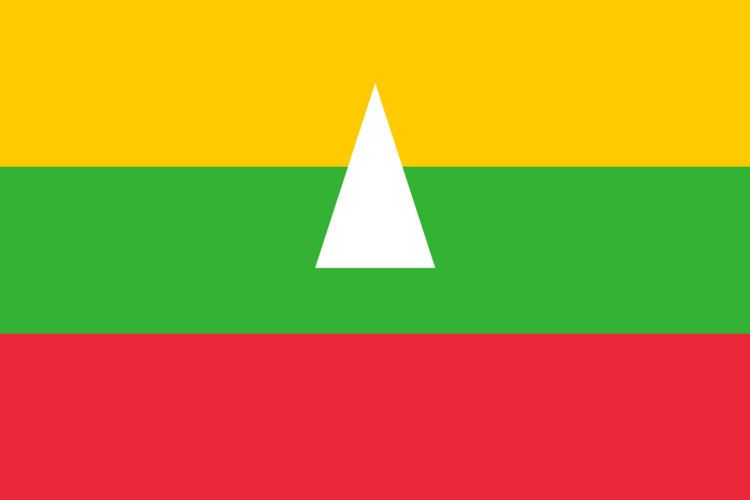Region Southeast Asia Longest river Ayeyarwady River Continent Asia | Coastline 1,930 km (1,200 mi) Area 676,578 km² | |
 | ||
Borders Total land borders:6,522 km (4,053 mi)Bangladesh:271 km (168 mi)People's Republic of China:2,129 km (1,323 mi)India:1,468 km (912 mi)Laos238 km (148 mi)Thailand:2,416 km (1,501 mi) Highest point Hkakabo Razi5881 m (19,294.62 ft) Lowest point Andaman Sea0 m (0 ft)(sea level) Neighboring countries | ||
Myanmar (also known as Burma) is the northwestern-most country on the mainland of southeast Asia. It is strategically located near major Indian Ocean shipping lanes.
Contents
- Map of Myanmar Burma
- Climate
- Mountains
- Main peaks
- Rivers
- Maritime claims
- Islands
- Natural hazards
- Environment
- Environment international agreements
- References
Map of Myanmar (Burma)
Climate
Tropical monsoon in the lowlands below 2,000 m (6,562 ft); cloudy, rainy, hot, humid summers (southwest monsoon, June to September); less cloudy, scant rainfall, mild temperatures, lower humidity during winter (northeast monsoon, December to April). Climate varies in the highlands depending on elevation; subtropical temperate climate at around 2,500 m (8,202 ft), temperate at 3,000 m (9,843 ft), cool, alpine at 3,500 m (11,483 ft) and above the alpine zone, cold, harsh tundra and Arctic climate. The higher elevations are subject to heavy snowfall and bad weather.
Mountains
Myanmar is characterised by its central lowlands with the Sittaung Valley and Chindwin Valley and the small mountain ranges of Zeebyu Taungdan, Min-wun Taungdan, Hman-kin Taungdan and Gangaw Taungdan as well as the Bago Yoma (Pegu Range), a relatively low mountain chain between the Irrawaddy and the Sittaung River in central Myanmar. The Central Valley Region is limited by steep, rugged highlands in the North, where ranges at the southern end of the Hengduan System form the border between Myanmar and China. Hkakabo Razi, the country's highest point at 5,881 m (19,295 ft), is located at the northern end of the country. This mountain is part of a series of parallel ranges that run from the foothills of the Himalaya through the border areas with Assam, Nagaland and Mizoram.
The Arakan Mountains in the west run from Manipur into western Myanmar southwards through Rakhine State almost to Cape Negrais in the shores of the Bay of Bengal. The Arakan Range includes the Naga Hills, the Chin Hills, and the Patkai range which includes the Lushai Hills.
In Eastern Myanmar the highest point of the Shan Hills is 2,563 m high Loi Pangnao, one of the ultra prominent peaks of Southeast Asia. The Shan Hills form, together with the Karen Hills, Dawna Range and Tenasserim Hills, a natural border with Thailand as well as the Kayah-Karen/Tenasserim moist forests ecoregion which is included in the Global 200 list of ecoregions identified by the World Wildlife Fund (WWF) as priorities for conservation. Southern Myanmar consists largely of the western slopes of the Bilauktaung, the highest part of the Tenasserim Range, which extends southwards forming the central range of the Malay Peninsula.
Main peaks
Rivers
The Irrawaddy, the main river of Burma, flows from north to south through the Central Burma Basin and ends in a wide delta. The Mekong runs from the Tibetan Plateau through China's Yunnan province entering Northeastern Burma into Laos.
In the east the Salween and the Sittaung River run along the western side of the Shan Hills and the northern end of the Dawna Range. In the narrow southeastern part of Burma, the Ye, Heinze, Dawei (Tavoy), Great Tenasserim (Tanintharyi) and the Lenya rivers are relatively short and flow into the Andaman Sea. Further south the Kraburi River forms the southern border between Thailand and Burma.
Maritime claims
contiguous zone: 24 nmi (27.6 mi; 44.4 km)
continental shelf: 200 nmi (230.2 mi; 370.4 km) or to the edge of the continental margin
exclusive economic zone: 200 nmi (230.2 mi; 370.4 km)
Islands
Natural hazards
Destructive earthquakes and cyclones; flooding and landslides common during rainy season (June to September); periodic droughts
Environment
Deforestation; industrial pollution of air, soil, and water; inadequate sanitation and water treatment contribute to disease
Environment - international agreements
party to: Biodiversity, Climate Change, Desertification, Endangered Species, Law of the Sea, Nuclear Test Ban, Ozone Layer Protection, Ship Pollution, Tropical Timber 83, Tropical Timber 94
signed, but not ratified: none of the selected agreements
